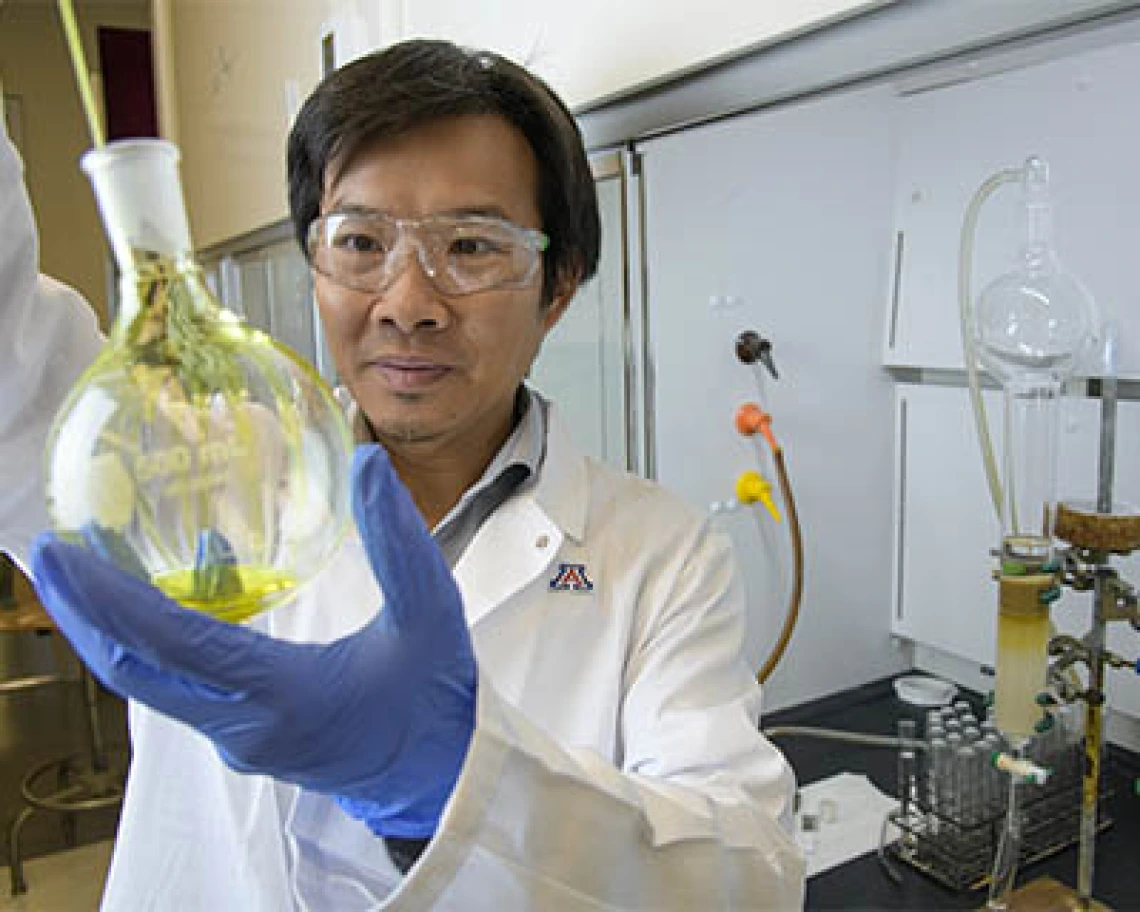UArizona Health Sciences Joint Study Finds Dual Inhibitor Strategy May Be Key to Sustainable COVID-19 Treatment
Researchers in the College of Pharmacy say compounds targeting proteins involved in viral replication may further drug development for treating COVID-19.

TUCSON, Ariz. — A University of Arizona Health Sciences researcher has identified a way to develop new drugs to treat COVID-19 by targeting two mechanisms of the viral replication process of SARS-CoV-2, the virus that causes COVID-19.

Jun Wang, PhD, is hoping to advance drug development for COVID-19 therapeutics by studying two compounds that inhibit key proteins involved in viral replication of SARS-CoV-2. (University of Arizona Health Sciences, Kris Hanning)
The study, recently published in Science Advances, offers insight into designing antiviral drugs against COVID-19. Jun Wang, PhD, associate professor of pharmacology and toxicology at the UArizona College of Pharmacy and one of the study’s senior co-authors, found that some existing compounds can inhibit a key viral protein required for SARS-CoV-2 replication inside human cells as well as a human protein important for viral entry into host cells.
“Knowing exactly how these compounds bind to a key SARS-CoV-2 protein will greatly speed up our process to deliver clinical drug candidates,” Dr. Wang said.
Dr. Wang, along with co-principal investigator Yu Chen, PhD, of the University of South Florida Health, examined two compounds – calpain inhibitor II and calpain inhibitor XII – to determine how they interact with the main protease (Mpro) of SARS-CoV-2 that enables replication. Mpro is an attractive drug target among coronaviruses because inhibiting it blocks viral replication, preventing the virus from infecting more cells.
In a prior study, Dr. Wang identified calpain inhibitor II and calpain inhibitor XII and found they have the ability to inhibit both Mpro and the human protein cathepsin L, a lysosomal protease. In this study, calpain inhibitors II and XII were shown to inhibit SARS-CoV as well as MERS-CoV and other seasonal human coronaviruses that cause common cold.
Using a powerful technique known as x-ray crystallography, the team gained a molecular-level understanding of how each compound interacted with the SARS-CoV-2 Mpro. Understanding how each compound interacts with the SARS-CoV-2 Mpro will allow researchers to develop modifications that could improve the interactions and ultimately design better drug candidates.
“Without that detailed understanding it is difficult to optimize these compounds to make them more effective,” Dr. Wang said.
There may be several advantages to pursuing a dual inhibitor approach that can target both the Mpro and cathepsin L rather than a mono-specific inhibitor that only seeks to inhibit one part of the virus. First, viruses may have a harder time evolving drug resistance to dual inhibitors. Second, dual inhibitors may be more effective because they attack multiple times during the viral replication cycle. Third, dual inhibitors may have a broader spectrum of antiviral activity compared with mono-specific inhibitors, meaning they could be used to target not only SARS-CoV-2, but also closely related coronaviruses.
Further research will explore the potential for improving the antiviral potency of calpain inhibitors II and XII against SARS-CoV-2 using structure-based drug design.
This research was funded in part by the National Institutes of Health (AI147325, AI157046, AI151638), the Arizona Biomedical Research Centre (ADHS18-198859), and the National Institute of General Medical Sciences NIH (R35 GM128624).
# # #
NOTE: Photos available here: https://arizona.box.com/s/hjnh6urnqcujipqt43lf1xf4wwom7p4j
About the University of Arizona College of Pharmacy
The University of Arizona College of Pharmacy is the premier pharmacy college in the Southwest, and one of the top in the nation, focused on drug discovery, toxicology, pharmaceutics, health outcomes and sciences, pharmaceutical education and research through interprofessional training and collaborative public/private partnerships. Preparing pharmacists and pharmaceutical scientists in undergraduate, professional, graduate and post-doctoral programs, the college embraces an entrepreneurial spirit, providing tailored educational opportunities to broaden students' experiences. Established 72 years ago as the first health sciences college at UArizona, the college has a long history of improving science and health, both in Arizona and around the world. It is currently ranked No. 8 among the nation’s 143 colleges of pharmacy by the American Association of Colleges of Pharmacy. For more information: pharmacy.arizona.edu (Follow us: Facebook | Twitter | Instagram | YouTube).
About the University of Arizona Health Sciences
The University of Arizona Health Sciences is the statewide leader in biomedical research and health professions training. UArizona Health Sciences includes the Colleges of Medicine (Tucson and Phoenix), Nursing, Pharmacy, and the Mel and Enid Zuckerman College of Public Health, with main campus locations in Tucson and the Phoenix Biomedical Campus in downtown Phoenix. From these vantage points, Health Sciences reaches across the state of Arizona, the greater Southwest and around the world to provide next-generation education, research and outreach. A major economic engine, Health Sciences employs nearly 5,000 people, has approximately 4,000 students and 900 faculty members, and garners $200 million in research grants and contracts annually. For more information: uahs.arizona.edu (Follow us: Facebook | Twitter | YouTube | LinkedIn | Instagram).

